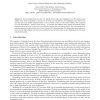Free Online Productivity Tools
i2Speak
i2Symbol
i2OCR
iTex2Img
iWeb2Print
iWeb2Shot
i2Type
iPdf2Split
iPdf2Merge
i2Bopomofo
i2Arabic
i2Style
i2Image
i2PDF
iLatex2Rtf
Sci2ools
APCHI
2004
IEEE
2004
IEEE
Does DOF Separation on Elastic Devices Improve User 3D Steering Task Performance?
We investigated the use of a new haptic device called the DigiHaptic in a 3D steering task. Unlike other devices intended to interact in 3D with one end-effector, the DigiHaptic has three levers that the user may handle simultaneously or not in elastic mode to rate control objects. We compared it to the SpaceMouse - another elastic device - to evaluate the influence that degrees of freedom (DOF) separation have in terms of accuracy (coordination and errors) and speed (time). The task consisted of steering paths that required the use of two or three DOF simultaneously. We found that users performed faster on the SpaceMouse but were less coordinated and accurate than on the DigiHaptic for the most complicated paths.
| Added | 20 Aug 2010 |
| Updated | 20 Aug 2010 |
| Type | Conference |
| Year | 2004 |
| Where | APCHI |
| Authors | Géry Casiez, Patricia Plénacoste, Christophe Chaillou |
Comments (0)

